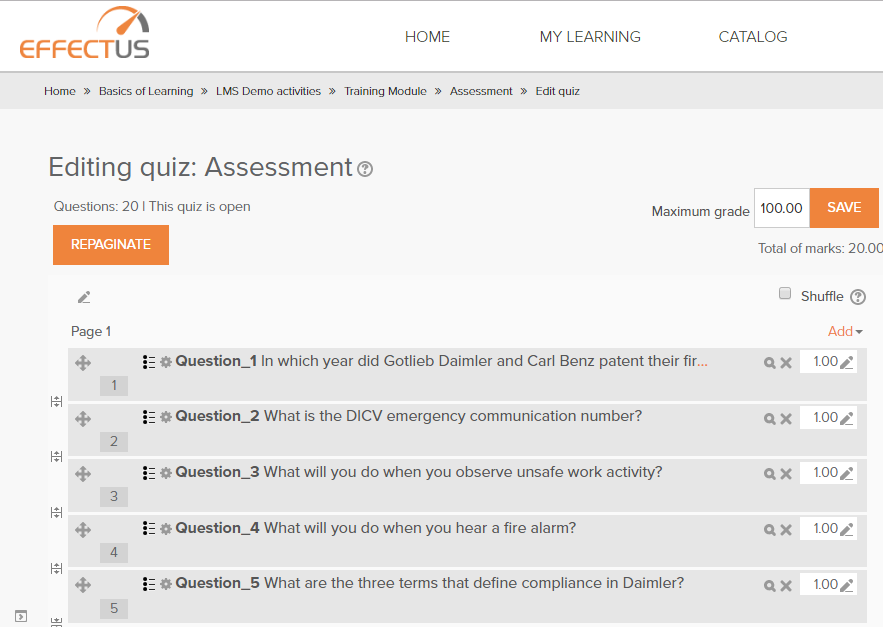How Will Randomizing Test Questions Help You Enhance E-learning Assessments?

Are assessments in your e-learning courses a memory test for learners or do they actually check if learners have understood what they have learned? It’s time for a reality check. An effective assessment in e-learning is not just about posing the right questions to learners. You also have to take care of the assessment design, so that it checks for knowledge retention.
What are Randomized Test Questions in E-learning?
Randomizing test questions is a great strategy to use when you want to check if learners have actually understood the content covered in the training program. Randomized test questions in e-learning courses fall under one of these categories:
- A finite number of questions are randomly pulled from a large question pool or question bank, so that each learner gets a different set of questions.
- Learners get the same questions, but the order in which these questions appear differs from one learner to the other.
Should you use randomized test questions in your e-learning courses? Without a doubt, yes! Here are some terrific reasons to use randomized test questions in e-learning.
1. Motivate Learners to Think
Consider a scenario where the learners in your organization have to pass an assessment (multiple choice questions) after an e-learning course completion. Some of them manage to pass while a few others do not and have to re-attempt the test questions. They are presented with the same questions again and this time they manage to pass.
Does this mean that learners have retained the knowledge covered in the training program? Not really! Because, if they had, they should have been able to do so in the very first attempt. What’s probably happened is that learners were able to rely on their memory to choose a different answer for the questions they earlier answered incorrectly.
Now consider using randomized test questions. If learners do not pass the first time round, they are presented with a different set of questions. They are forced to draw on their learning experience to pass the assessment. Learners are required to think through the solution carefully instead of relying only on their memory of the previous test attempt.
2. Provide a Variety of Questions
Recycling the same set of questions does not make for interesting tests in e-learning. Delivering the same set of questions for every attempt the learner makes on the test, only facilitates rote learning. To assess knowledge retention, present learners with randomized test questions. Presenting a variety of questions enhances learners’ interest in the assessment and they would want to pay attention to course content.
3. Improve Quality of Assessments
It is possible to group questions within a question pool based on topics or modules in the e-learning course or difficulty level. Instructional designers make use of revised Bloom’s taxonomy to craft questions that map to the learning objectives and also differ in difficulty level.
- Level 1 – Remembering
- Level 2 – Understanding
- Level 3 – Applying
- Level 4 – Analyzing
- Level 5 – Evaluating
- Level 6 – Creating
Each group in the question pool contains various types of questions and each group can have a specific weightage when it comes to scoring. For example, you can assign a lower score while testing recall of simple facts (Bloom’s level 1) and give a higher weightage when you are assessing learners on how they are applying knowledge or techniques gained from the e-learning course to solve a problem (Bloom’s level 3). You can set the randomized test to draw a finite number of questions from each pool. Doing so ensures the quality of assessments.
4. Give Learners an Opportunity to Practice
Randomized test questions offer learners an opportunity to practice, by letting them attempt diverse sets of questions. Learners are required to recall the knowledge gained from the e-learning course to answer the test questions correctly. For example, an assessment in an online compliance training course where learners get the same questions but in a different order may include a scenario for which the learner has to choose the correct option.
In the next attempt, the learner might be presented with a completely different scenario, and is again required to recall the course content. This active retrieval of information facilitates knowledge retention and improves the effectiveness of the assessment in the e-learning course.
5. Make it Possible to Reuse Questions
Not all questions in a question pool are delivered to the learner. So, if you have learners completing an e-learning curriculum, the test questions in the basic level of the course can serve as a randomized pre-test for the advanced level of the course. This is also a good strategy to save on the time taken to frame test questions in e-learning.
Most modern Learning Management Systems (LMSs) have a built-in quiz engine that lets you move questions from one question bank to another easily. The order of questions as well as the options can be randomized through the quiz engine.


Also, most authoring tools such as Articulate Storyline and Lectora Inspire offer templates for designing assessments and make it easy to randomize test questions included in the e-learning course.
The number of questions to include and the length of the assessment is largely determined by the type of course or training you are providing to your learners. Randomizing test questions in e-learning courses is a great way to assess your learners while they acquire the required knowledge and skills that are essential at the workplace.





